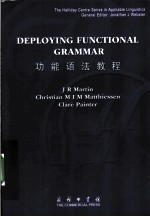

功能语法教程PDF电子书下载
- 电子书积分:12 积分如何计算积分?
- 作 者:(澳)詹姆斯·R·马丁,(瑞典)克里斯琴·MIM·马西森,(澳)克莱尔·佩因特著
- 出 版 社:北京:商务印书馆国际有限公司
- 出版年份:2010
- ISBN:9787100068512
- 页数:307 页
Chapter 1 Introduction 1
1.What is functional grammar? 1
2.Why this functional grammar? 2
3.Using the workbook 3
4.Getting started with text analysis 5
5.Constituency:functional and class units 7
6.Reasoning in a functional grammar 10
7.Paradigms as system networks 13
8.Choice and constituency 16
9.Learning to use IFG 19
Chapter 2 Theme—clause as message 21
1.Orientation 21
1.1 Reading guide to IFG 21
1.2 Characterisation of Theme 21
1.3 Thematic development within a text 22
2.Survey of options 22
2.1 Ideational(topical)Theme 24
2.2 Interpersonal Theme 25
2.3 Textual Theme 25
2.4 Summary of types of Theme 26
2.5 Extending the thematic principle beyond the clause 27
3.Troubleshooting 28
3.1 Picking out the unit of analysis 28
3.2 Identifying the Theme 28
3.3 Identifying the metafunction 29
3.4 Subject it as unmarked topical Theme 32
3.5 There's a...:'Existental'clauses 35
3.6 Recognising longer Theme units 35
3.7 'Hypotactic'clause as Theme 37
4.Analysis practice 38
4.1 Phase Ⅰ 38
4.2 Phase Ⅱ 40
4.3 Phase Ⅲ 47
5.Review and contextualisation 52
5.1 Defining Theme 52
5.2 The location of THEME within the grammatical resources of English 52
5.3 Theme and Metafunction 53
5.4 Theme and Mood 54
Further reading 54
Chapter 3 Mood—clause as exchange 56
1.Orientation 56
1.1 Reading guide to IFG 56
1.2 Characterisation of Mood 56
2.Survey of options 59
2.1 Basic MOOD types 60
2.2 Overall interpersonal organisation of the clause 60
2.3 Interpersonal grammatical metaphor 67
3.Troubleshooting 69
3.1 The unit of analysis 69
3.2 Identifying structural elements 70
3.3 Ambiguous mood type 75
3.4 Ambiguous polarity 76
4.Analysis practice 77
4.1 Phase Ⅰ 77
4.2 Phase Ⅱ 82
4.3 Phase Ⅲ 89
5.Review and contextualisation 93
5.1 Locating MOOD 93
5.2 Interpersonal structure 95
5.3 Interpersonal structure and textual structure 95
Further reading 96
Chapter 4 Transitivity—clause as representation 98
1.Orientation 98
1.1 Reading guide to IFG 98
1.2 Characterisation of TRANSITIVITY 98
2.Survey of options 100
2.1 Material clauses 102
2.2 Mental clauses 103
2.3 Relational clauses 104
2.4 Verbal clauses 106
2.5 Behavioural clauses:between material and mental/verbal 107
2.6 Existential clauses 108
2.7 Additional Agents 108
2.8 Ergative interpretation 109
3.Troubleshooting 112
3.1 A topology of processes 112
3.2 General probes helpful in analysing for TRANSITIVITY 113
3.3 One process or two? 114
3.4 Material clauses 115
3.5 Mentml clauses 118
3.6 Relational clauses 120
3.7 Verbal clauses 124
3.8 Behavioural clauses 125
3.9 Discriminating circumstance type 126
3.10 Distinguishing between circumstances and other elements 126
4.Analysis practice 130
4.1 Phase Ⅰ 130
4.2 PhaseⅡ 137
4.3 Phase Ⅲ 146
5.Review and contextualisation 153
5.1 The clause as experiential construct 153
5.2 Ergative perspective 155
5.3 Relation to other metafunctions 155
Further reading 159
Chapter 5 Group and phrase—below the clause 161
1.Orientation 161
1.1 Reading guide to IFG 161
1.2 Characterisation of groups/phrases 161
2.Survey of options 165
2.1 Nominal group 165
2.2 Verbal group 171
2.3 Other groups 182
2.4 Prepositional phrase 183
3.Troubleshooting 185
3.1 Identifying groups/phrases 185
3.2 Assigning a function to a word in a group 186
3.3 Different meanings for prepositions 196
3.4 Assigning a function to a phrase or a clause:ranking or embedded? 198
4.Analysis practice 200
4.1 Nominal group 201
4.2 Verbal group 212
4.3 Adverbial group & Prepositional phrase 224
5.Review and contextualisation 224
5.1 Locating groups & phrases:rank and metafunction 224
5.2 Nominal group 225
5.3 Verbal group 226
5.4 Prepositional phrase 226
Further reading 227
Chapter 6 The clause complex—above the clause 229
1.Orientation 229
1.1 Reading guide to IFG 229
1.2 Characterisation of clause complex 229
2.Survey of options 231
2.1 TAXIS 231
2.2 Logico-semantic type 234
2.3 Summary of clause complex relations 237
3.Troubleshooting 238
3.1 Procedure for analysis 238
3.2 Picking out the unit of analysis 238
3.3 Complexing vs.embedding 242
3.4 Parataxis or hypotaxis? 247
3.5 Identifying the logico-semantic relation 248
3.6 How many'layers'to the clause complex? 250
3.7 Implicit clause complex relations 251
3.8 Projection 251
3.9 'Surfacing'from an embedding 252
4.Analysis practice 253
4.1 Phase Ⅰ 253
4.2 Phase Ⅱ 259
4.3 Phase Ⅲ 265
5.Review and contextualisation 268
5.1 Review 268
5.2 Relations between clauses 270
Further reading 271
Chapter 7 Text analysis 272
1.Orientation 272
1.1 Reading guide to IFG 272
1.2 Characterisation of text analysis 272
2.Grammar and beyond 274
2.1 Theme and information flow 276
2.2 Clause complexing and conjunction 278
2.3 Transitivity and ideation 283
2.4 Nominal groups,ideation and identification 284
2.5 Periodicity and appraisal 288
2.6 Deixis and multimodality 291
3.Text analysis cartography 293
References 299
Index 303
- 《高级英语阅读与听说教程》刘秀梅编著 2019
- 《看图自学吉他弹唱教程》陈飞编著 2019
- 《激光加工实训技能指导理实一体化教程 下》王秀军,徐永红主编;刘波,刘克生副主编 2017
- 《AutoCAD 2019 循序渐进教程》雷焕平,吴昌松,陈兴奎主编 2019
- 《少儿电子琴入门教程 双色图解版》灌木文化 2019
- 《培生高级英语语法 练习册》培生教育 2019
- 《Photoshop CC 2018基础教程》温培利,付华编著 2019
- 《剑桥国际英语写作教程 段落写作》(美)吉尔·辛格尔顿(Jill Shingleton)编著 2019
- 《英语自学进阶教程全6册 3》爱尔兰迪尔德丽出版社著 2019
- 《雅马哈管乐队训练教程 降E调单簧管 分谱》Japan Band Clinic委员会 2019
- 《社会学与人类生活 社会问题解析 第11版》(美)James M. Henslin(詹姆斯·M. 汉斯林) 2019
- 《公主小姐不想吃饭》(法)克里斯汀·诺曼·维拉蒙著(法)玛丽安娜·巴尔西隆绘苏迪译 2019
- 《超级参与者》王金强责编;赵磊译者;(澳)杰里米·海曼斯,(英)亨利·蒂姆斯 2020
- 《我才是真的公主!》(法)克里斯汀·诺曼·维拉蒙,苏迪,(法)玛丽安娜·巴 2019
- 《空气动力学 7 飘浮的秘密》(加)克里斯·费里著 2019
- 《战略情报 情报人员、管理者和用户手册》(澳)唐·麦克道尔(Don McDowell)著 2019
- 《大历史 虚无与万物之间 全彩插图版》(美)大卫·克里斯蒂安,辛西娅·斯托克斯·布朗,克雷格·本杰明著;刘耀辉译 2017
- 《莎莎有颗重重的心》(澳)彼得·卡纳沃斯著 2018
- 《我的牧羊日记》(瑞典)艾克瑟·林登著 2019
- 《什么都要可以吗?》(法)克里斯汀·诺曼·维拉蒙著;(法)玛丽安娜·巴尔西隆绘;苏迪译 2019
- 《指向核心素养 北京十一学校名师教学设计 英语 七年级 上 配人教版》周志英总主编 2019
- 《剑桥国际英语写作教程 段落写作》(美)吉尔·辛格尔顿(Jill Shingleton)编著 2019
- 《北京生态环境保护》《北京环境保护丛书》编委会编著 2018
- 《国际经典影像诊断学丛书 消化影像诊断学 原著第3版》王振常,蒋涛,李宏军,杨正汉译;(美)迈克尔·P.费德勒 2019
- 《商务英语口译教程 第3版》朱佩芬,徐东风编著 2017
- 《指向核心素养 北京十一学校名师教学设计 英语 九年级 上 配人教版》周志英总主编 2019
- 《实用商务英语听说 第1册》窦琳,江怡平主编 2019
- 《英语实训教程 第2册 商务英语听说》盛湘君总主编 2019
- 《齐心开创共建“一带一路”美好未来 在第二届“一带一路”国际合作高峰论坛开幕式上的主旨演讲》习近平著 2019
- 《高等院校旅游专业系列教材 旅游企业岗位培训系列教材 新编北京导游英语》杨昆,鄢莉,谭明华 2019
